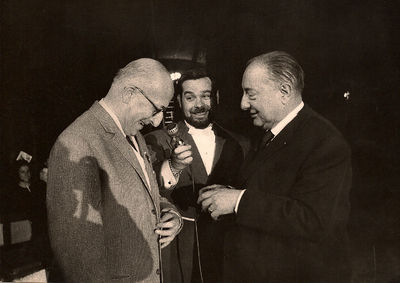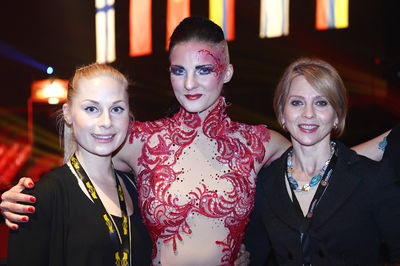Difference between revisions of "Festival Mondial du Cirque de Demain"
From Circopedia
(→Image Gallery) |
(→Image Gallery) |
||
| Line 34: | Line 34: | ||
File:Festival_Cirque_de_Demain_-_Ringmasters.jpg|Ringmasters' reunion at the 19th Festival. Dominique Mauclair stands in the center, in blue ringmaster costume (1996) | File:Festival_Cirque_de_Demain_-_Ringmasters.jpg|Ringmasters' reunion at the 19th Festival. Dominique Mauclair stands in the center, in blue ringmaster costume (1996) | ||
File:Festival_du_Cirque_de_Demain_1977.jpg|Program Cover for the 20th Festival (1997) | File:Festival_du_Cirque_de_Demain_1977.jpg|Program Cover for the 20th Festival (1997) | ||
| − | File: | + | File:Cirque_de_Demain_2004.jpeg|Program Cover for the 25th Festival (2004) |
File:Jansson,_Vintilova,_Panova_(2014).jpg|Swinging Trapeze Gold Medal winners Uuve Jansson (2011), Darya Vintilova (2006), and Elena Panova (1987) at the 35th Festival (2014) | File:Jansson,_Vintilova,_Panova_(2014).jpg|Swinging Trapeze Gold Medal winners Uuve Jansson (2011), Darya Vintilova (2006), and Elena Panova (1987) at the 35th Festival (2014) | ||
</gallery> | </gallery> | ||
Latest revision as of 22:26, 5 June 2019
The "Paris Festival"
By Dominique Jando
La Piste
La Piste had been established in 1927 to assist retired and injured circus artists in financial difficulty. It was presided from 1947 to 1976 by Louis Merlin (1901-1976), a well-known pioneer of French commercial radio, a circus aficionado, and a remarkable public relations wizard. Starting in 1958, La Piste's main fund raising event was the Gala de la Piste, a black-tie gala featuring some of the world's greatest circus acts, which was produced by Dominique Mauclair and staged at Paris's Cirque d'Hiver-Bouglione (with a few excursions to Cirque Napoléon Rancy, Cirque Medrano, and Cirque Jean Richard).
By 1976, La Piste had helped solve most of the problems that had plagued French circus performers when they wanted to retire or needed medical coverage. Louis Merlin wanted the organization to shift its focus toward another worthy circus cause that needed attention—and Mauclair suggested an international circus festival for young, upcoming circus performers. The idea behind the project was that the first western circus schools had been created two years earlier, and young performers who didn't come from circus families were going to need a place where to showcase their talents in front of journalists, agents, and directors.
Louis Merlin never saw the project come to fruition: he died unexpectedly at the end of 1976. The festival was held for the first time, as an adjunct to the 19th Gala de la Piste, on Wednesday, January 5, 1977 at the Cirque d'Hiver-Bouglione in Paris. In a tribute to Louis Merlin, it was called Concours International des Bourses Louis Merlin. The first winners were a young Colombian hand-balancing trio, The Wee Gets. Later, the founders often joked that, at this first festival, there were more people at the finale in the ring than in the house...
Le Cirque de Demain
The second festival was held in November of the same year, 1977, and took the name of Le Cirque de Demain ("The Circus of Tomorrow"). It was still linked to the Gala de la Piste. The 3rd festival, in June 1979, moved to the big topThe circus tent. America: The main tent of a traveling circus, where the show is performed, as opposed to the other tops. (French, Russian: Chapiteau) of Alexis Gruss's Cirque à l'ancienne—home of one of Paris's two circus schools. By then, the Festival had found its style, notably with the distribution of gold, silver, and bronze medals. The first Gold Medal winners, that year, were the young Alexis Brothers. 1981 saw the last edition of the Gala de la Piste. In 1982, the Festival took a life of its own, with a new and final name, the Festival Mondial du Cirque de Demain.
Over the years, the Festival Mondial du Cirque de Demain had revealed to the world some of the most extraordinary circus artists of the contemporary circus, from Miss Enhtsetseg, the Mongolian contortionist, to David Shiner, the American clownGeneric term for all clowns and augustes. '''Specific:''' In Europe, the elegant, whiteface character who plays the role of the straight man to the Auguste in a clown team.; from the first acts created by Montréal's National Circus School for the nascent Cirque du Soleil, to the Russian aerialistAny acrobat working above the ring on an aerial equipment such as trapeze, Roman Rings, Spanish web, etc. Elena Panova, who revolutionized swinging trapeze; from the ground-breaking creations of Russian director Valentin Gneushev to Daniel Cyr and his new invention, the Roue Cyr; from the first North Korean flyers seen in the West to the latest Chinese acrobatic productions. New concepts, new styles, new visions, have emerged from the Festival, and the contemporary circus has been patiently defined year after year in each edition of the Festival Mondial du Cirque de Demain.
Every year, circus agents and directors from all over the world meet in Paris to discover the circus talents of the next generation. The Festival's list of medalists (see the Festival's visual history on its website) reads like a Who's Who of today's major circus stars. It has become, over the years, the world's greatest market for new circus acts, and the crucible where the circus of tomorrow constantly reinvents itself.
Image Gallery
Suggested Reading
Pascal Jacob, Festival Mondial du Cirque de Demain — Trente Ans (Paris, Magellan & Cie, 2009) ISBN 978-2-35074-156-7










